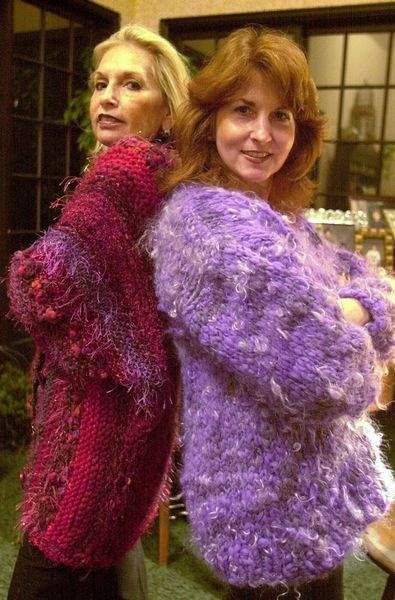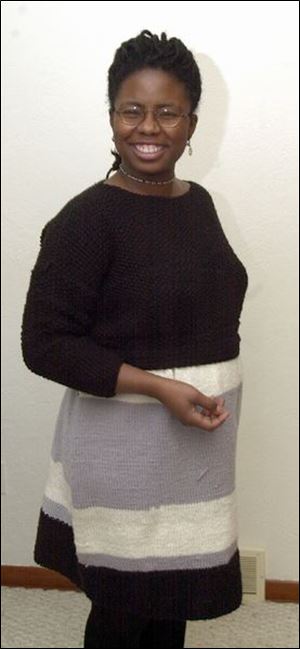
The art, craft of knitting appeals to new generation of fans
1/21/2001
Nancy Zerner, left, and Nancy Shall model sweaters knitted by Sandy Saferin.
Call it an art, call it a craft, you'll get no fight. For the contrasts between the fiber sculptures of Valentina Devine and the utility of the late Elizabeth Zimmerman's creations show knitting is both.
And it is enjoying a renaissance on both coasts and among diverse people.
There are knit-ins on the streets of New York for which thousands turn out. Julia Roberts has confessed her preoccupation with it to Oprah.Mary Colucci, Big Apple spokeswoman for the North Carolina-based Craft Yarn Council of America, mentions that, among others, Vanna White, Kate Hudson, Hillary Swank, and Cameron Diaz have been spotted wielding needles and yarn.
The Knitting Guild of America has reported a significant increase in membership, with its local chapter, Holey Toledo (it meets monthly in the Starlight Plaza Churchill's store), holding its own.
Today's knitters may think they're picking up an old pastime, but it is one being freshened up by young designers such as Lily Chin and the princess of cabling, Norah Gaughan.
Many younger people have discovered knitting as a way to afford runway chic.
Any of the lithe, glam set who adored the fluffy white-mohair, big-cabled and big-bobbled $1,700 Dior confection Winona Ryder sported on the cover of Vogue in October, 1999, will want to check out the fall/winter Vogue Knitting International for a sweater by Oscar de la Renta that seems, well, awfully similar. Big cables, big bobbles, but fewer of them, and a tighter neck - which could be knitted for, say, $100.
Ellen Upp, owner of the Fifth Stitch in Defiance, says fashion is moving more quickly from the runways and racks of Seventh Avenue into the newsstand knitting magazines.
Though fashion and price may have jump-started knitting among the teen and 20-something sets on both coasts, since the mid-'90s, for many knitters in Northwest Ohio and Sutheast Michigan, knitting is about keeping on keeping on, or returning from a respite.

Melissa Jeter, an enthusiastic knitter, models one of the dresses she made.
What's hot in Midwest knitting this season, according to fine-yarn purveyors, are trendy shawls, multicolored and textured sweaters of novelty yarns as well as the mitered designs, including the Mitered Mozart sweater, featured in the Spring 2000 Knitter's Magazine. Plus fancy socks shown off in clogs, mittens, and scarves, from frothy mohair laces to sensible classics.
Why knit?
The answers are as varied as knitters. They may or may not involve saving money, or making it.
Doing work that has an outcome, something one can feel, touch, see, wear, and admire is a universal satisfaction. Knitting is tactile; hands caress fiber and fiber caresses back.
“It's just amazing to be able to know that I can create things with my hands,” said Melissa Jeter of Toledo, who taught herself to knit 13 years ago, when she was 17.
Ms. Jeter, who works for a community organization, uses yarn that people give her, recycled yarn, and inexpensive acrylics available at discount stores.
Her enthusiasm is no less passionate than that of Toledoan Sandy Saferin, who returned to her needles a dozen years ago and began using combinations of tony fibers, from the thin and fat multicolored chunkies by Colinette, to the curly-wool hand-dyed yarns from Rainbow Mills in Pennsylvania, to Chilean angoras.
From them and other novelty fiber sources she creates unique chunky afghans and sweaters that are the rage in upscale boutiques. She also offers them on her Web site.
But more than that, “It's my creative outlet,” Mrs. Saferin says. “Anytime you can make any kind of aesthetic choice it's good for you. Knitting relaxes me. I look forward to doing it."
Relaxation is the draw for 24-year-old Megan Myers of Toledo, who has been teaching herself to knit for about a year. So is the social aspect. When you knit, you can listen, talk, watch TV, and mind the baby. It doesn't take all your attention.
Knitting teaches a lot about forgiveness, too. It is one of the few things in life where one can make egregious mistakes, rip them out, and start over again. No scars, no recriminations, no signs of hurt or slight - very Zen-ish.
Portability is a big thing, too. Young moms take knitting to school while they wait for teacher's conferences, and to doctors and dental appointments, where waiting is de rigueur. Riding along to McDonald's or anywhere else works for knitters, too. In the time it takes to get from Defiance to Columbus, Ellen Upp says, she can produce one mitten.
Education is another factor. A group of young girls in the Toledo Montessori after-school program are learning to knit. At the private Waldorf Schools (there's one in Detroit), youngsters learn to knit before they learn to read. It's viewed as helping brain development along.
And one knitting mother tells of a math teacher in Novi, Mich., who persuaded some students of both genders to try knitting because of its mathematical applications.
The youngest client at the Knit A Round shop has been a 4-year-old who makes blankets for her dolls. At Fifth Stitch, ages range from 8 to 85. At Flat Rock's Yarn Tree, they run from teenagers to 60- and 70-somethings.
Charity is another spur for knitting. One interesting program at the University of Michigan spread to Ohio State University. Knitting (and crocheting) in both places links students, staff, and faculty who call themselves Knitwits with nearby and distant communities through service programs.
The Michigan Knitwits organization is unusual. It has no meetings, no dues, no deadlines, and no officers. People bring yarn from stores and yard sales as well as overflow from personal and family stashes, plus needles and pattern books to a central place where knitters pick up what they want and where they return finished goods. Corporations also provide raw materials.
Sheri Prebetes, an owner of Knitting A Round, says she has told her minister she could concentrate better on his sermon if she could knit in church. Permission wasn't forthcoming, so she hasn't yet.
Ms. Jeter says she knits regularly while attending services at First Unitarian Church in Toledo. “Knitting is very spiritual,” she says. “It puts me in a different kind of space.”
Men who knit
That would be no surprise to Witt Pratt, who has been knitting for 18 years and is one of the “men who knit” who tell their story at www.knitting.about.com. "When people are actively knitting, my extensive scientific research has shown that it is impossible to discharge an automatic or semiautomatic weapon without serious rigging,” he says.
Nor would it surprise Toledoan Wayne Anthony, who teaches music at a private school. “I find knitting meditative,” he says. “Repetitive motion activities release serotonin in the brain. If I'm in a knitting mode and go without doing it a few days, I get cranky. I want that serotonin boost.”
Art or craft, knitting does not require a double X chromosome. To be sure, most knitters are female. But Betty Sperling recalls a young man who learned from his grandmother and knit coats and sweaters for his girlfriend. Some gay men knit for their partners. And, says Ms. Sperling, some men have been sent to her by doctors, who prescribed knitting to relieve tension and to rebuild fine motor skills in hands damaged, say, in a motorcycle accident.
In A History of Hand Knitting, Richard Rutt documents a lengthy male involvement in the craft, including Geoffrey Fisher, the Archbishop of Canterbury from 1945 to 1961, who taught his sons to knit in the 1930s and 1940s.
“Knitting is a distinct value,” Mr. Rutt says, quoting the archbishop. “It is reflective and repetitive. Whenever you are engaged in doing a purely repetitive thing, your mind can reflect on life. When knitting a sufficiently complex pattern, it's even impossible to think anything evil about anyone,” he says, urging complex patterns on everyone.
Mr. Rutt also documents knitting's use as a cure for smoking, a saver of reason during sudden onset of blindness, and, in Finland in 1938-'39, part of survival training for soldiers on skis. Sailors the world over have been the most famous of knitting men. But designers, from sculptor Paul Cochrane to color-king Kaffe Fassett, to intarsia and color artist Rick Mondragon, have upgraded knitting's creativity quotient.
A friend of a male knitter in the “men who knit” group calls knitting by men “a babe catcher.”
For Mr. Anthony, knitting - these days manageable projects like hats, socks, and mittens -is a means of individual expression and a way to own and wear “neat stuff,” that marries art and utility.
The cost of knitting
While knitting may save considerable money if you knock off boutique fashion with your own yarn - the price devil is in the labor and the markup - today's yarns can be expensive, with fine novelties and unusual wools running to $20 or $30 for a three-and-a-half-ounce skein. That seems a tad ahead of inflation. Fifty years ago, four ounces of four-ply worsted seemed steep at $2 or less.
It's not unusual for people to ante up $100 for wool for a single sweater, says Sue Child of the Yarn Farm. Fibers for many garments can go for twice that. Inflation plays a role, she says.
But, says Toledo knitting entrepreneur Sandy Saferin, “made by hand” isn't the same as homemade. These days, handmade is professional and up-to-date, fashioned with the help of the latest gadgets, bobbins, stitch holders, markers, and needles. A knitter can buy aluminum needles for $5 or $6, or the latest brass-tipped Addis for $11 to $13.
Fashion in this country began making knitting expensive in the 1920s, when the upper-crusts began sporting multi-colored and shaded Fair Isle sweaters and vests. Within a decade or two the lush, creamy and cabled Aran patterns, which took less time to make than the fishermen ganseys from which they were adapted, were all the rage.
In Ireland, knitters now sell Aran cabled sweaters in reds and blues, jade greens, tans, and browns as well as the traditional creams.
Everything about knitting changes. Yet it remains all it ever has been.